Discovering matted fur on your beloved feline friend can be a source of worry and frustration for both of you. Cats are renowned for their meticulous self-grooming habits, so tangled fur often signifies an underlying issue, a lack of regular brushing, or a combination of both. Regardless of the cause, addressing those stubborn knots requires a gentle and patient approach. This comprehensive guide equips you with the knowledge and techniques to tackle matted fur and keep your kitty comfortable throughout the process.
What Causes Matted Fur in Your Cat?
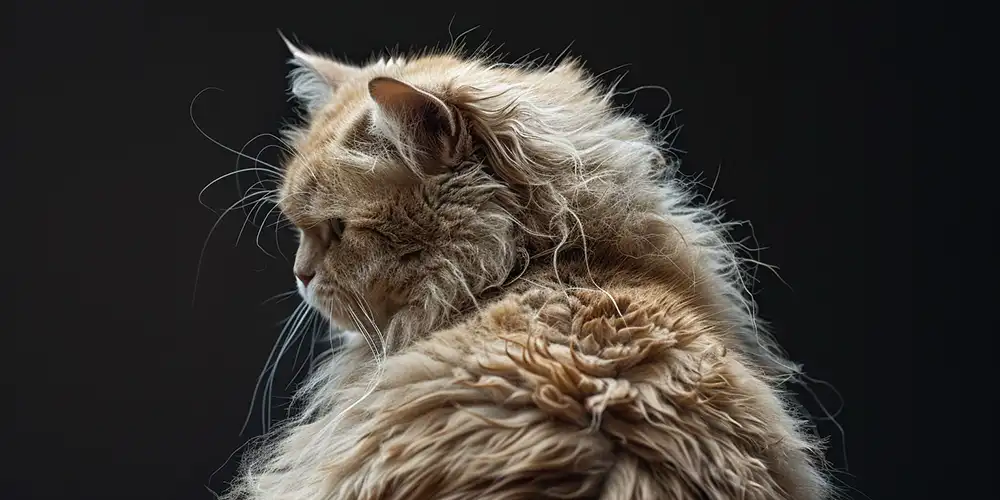
Matted fur, also known as knots, forms when loose hairs become entangled and clump together. There’s a multitude of factors that can contribute to this unwelcome development:
- Lack of Brushing: Regular brushing is the cornerstone of preventing matted fur. Brushing removes loose hair before it has a chance to tangle. Longhaired cats and breeds with thick undercoats, such as Maine Coons or Persians, require more frequent brushing compared to their shorthaired counterparts. A daily brushing routine is ideal for these breeds, while short-haired cats might benefit from brushing a few times a week.
- Excess Weight: Overweight or senior cats may struggle to reach certain areas while grooming themselves, leading to matting on their back, legs, or around the tail. This is especially true for senior cats who might also experience decreased flexibility or agility.
- Medical Conditions: Underlying medical issues can cause discomfort during grooming, discouraging your cat from properly cleaning their fur. Skin allergies, dental problems, or arthritis are all potential culprits. If you notice matting and suspect a medical condition, consulting your veterinarian is crucial to address the root cause and ensure your cat’s comfort.
- Dehydration: Dry skin lacks the natural oils that help keep fur smooth and manageable. This dryness makes fur more prone to tangles and matting. Ensure your cat has access to fresh, clean water at all times to promote healthy hydration and prevent dry, mat-prone fur.
- Stress and Anxiety: Stressful situations can have a significant impact on your cat’s behavior, including their grooming habits. Anxiety might cause them to neglect their usual grooming routine, leading to matted fur. Identifying and addressing potential stressors in your cat’s environment can help prevent future matting problems.
- Improper Diet: A diet lacking essential nutrients can negatively impact fur quality and contribute to matting. Ensure your cat receives a balanced diet formulated for their age and activity level. Consult your veterinarian for guidance on choosing the best food for your feline companion.
- Breed: Certain cat breeds, like Persians or Ragdolls, are blessed with long and thick fur that requires extra grooming attention. These breeds are particularly susceptible to matting if their fur isn’t brushed regularly.
- External Factors: Don’t underestimate the power of the outdoors! Burrs, matted grass, or other debris picked up during outdoor adventures can snag on your cat’s fur and contribute to matting. Regularly checking your cat’s fur after outdoor playtime can help prevent these external factors from causing problems.
Understanding the potential causes of matted fur in your cat is crucial. By addressing the root of the problem, you can not only deal with the existing knots but also prevent future tangles and maintain your cat’s comfort and well-being.
How to Prevent Mats from Coming Back
Once you’ve successfully addressed any existing matted fur, here are some proactive steps you can take to prevent future tangles:
- Establish a Brushing Routine: As mentioned earlier, brushing is the key to preventing matting. Develop a regular brushing routine based on your cat’s breed and fur length. Longhaired cats and those with thick undercoats require daily brushing, while shorthaired breeds might benefit from brushing every other day or a few times a week.
- Invest in the Right Brush: Choosing the right brush for your cat’s fur type is essential. For longhaired cats, a slicker brush and a metal comb are a good combination. Slicker brushes gently remove loose hair, while metal combs help detangle any minor knots. Shorthaired cats might benefit from a rubber grooming mitt or a bristle brush.
 |  |
- Make Brushing Time Positive: Brushing should be a positive experience for your cat. Use gentle strokes and reward your cat with praise or treats throughout the process. Keep brushing sessions short and sweet, especially if your cat isn’t used to it.
- Maintain a Healthy Diet: A balanced diet rich in essential fatty acids like Omega-3 and Omega-6 promotes healthy skin and fur, making it less prone to dryness and matting. Consult your veterinarian for guidance on choosing a nutritious diet for your cat.
- Address Underlying Medical Conditions: If you suspect an underlying medical condition might be contributing to matting, consult your veterinarian for diagnosis and treatment. Addressing the root cause will help prevent future matting issues.
- Regular Weight Management: Maintaining a healthy weight for your cat can improve their flexibility and agility, allowing them to groom themselves more effectively and reach all areas of their fur.
- Monitor Outdoor Cats: For outdoor cats, regularly check their fur for any burrs, matted grass, or debris that could contribute to tangles. Consider keeping outdoor playtime limited to controlled areas with minimal exposure to these potential matting hazards.
By implementing these preventative measures, you can significantly reduce the chances of your cat developing matted fur in the future. Remember, consistent brushing and a healthy lifestyle are the cornerstones of keeping your feline friend’s fur tangle-free and promoting their overall well-being.
What NOT to Do If Your Cat Gets Mats
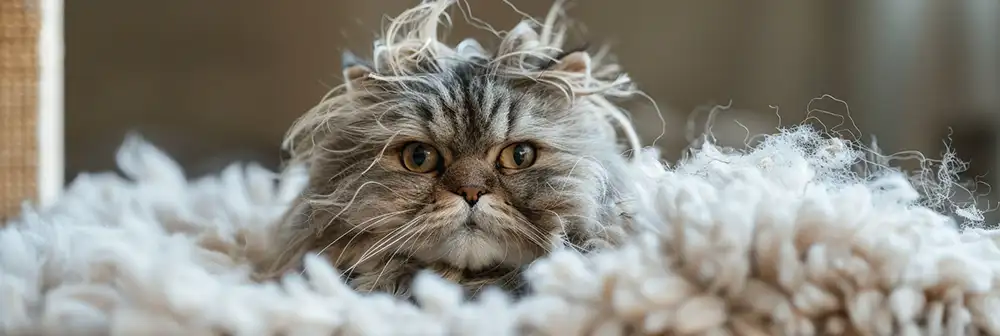
Discovering matted fur on your cat can be tempting to tackle head-on, but there are some approaches to avoid:
- Forcing Detangling: Severely matted fur can be painful to remove, especially if pulled on forcefully. Forcing detangling will only stress your cat and potentially damage their skin. Patience and a gentle approach are key.
- Using Scissors or Razors: Reaching for scissors or razors to cut out mats is a recipe for disaster. Not only could you accidentally injure your cat, but uneven cuts can leave them feeling exposed and uncomfortable. It’s best to leave any cutting to a professional groomer.
- Harsh Shampoos or Detanglers: We don’t even recommend to bathe your cat (discussed later in FAQ), and using harsh shampoos or detanglers can irritate your cat’s skin and worsen the situation. Consult your groomer or veterinarian before using any products on matted fur.
- Ignoring the Problem: Leaving matted fur unattended can be detrimental to your cat’s health. Mats can trap moisture and create a breeding ground for bacteria, leading to skin infections. Additionally, severe matting can restrict blood flow and cause discomfort.
- Yelling or Punishing Your Cat: Matted fur is often not the result of your cat being naughty. Yelling or punishing them will only damage their trust and make the situation worse. Focus on resolving the matting issue calmly and positively.
If you discover matted fur on your cat, resist the urge to take drastic measures. The next section will guide you through gentle detangling techniques and help you decide when professional intervention might be necessary.
What You Can Do and How to Detangle Matted fur Safely
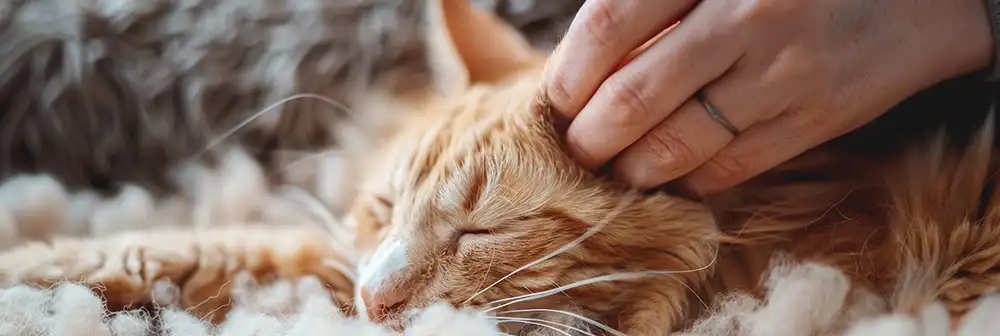
Now that you know what to avoid, let’s explore some safe and effective ways to detangle your cat’s fur:
- Gather Your Supplies: Before you begin, gather the necessary tools: a slicker brush, a metal comb, a dematting comb (optional but helpful for stubborn mats), detangling spray (consult your vet first!), a mat cutter (for minor, safe situations), treats, and a quiet, well-lit space.
- Create a Positive Environment: Make the detangling process as stress-free as possible for your cat. Choose a quiet, well-lit space and lay down a towel for them to feel comfortable. Offer calming words and treats throughout the session. If your cat seems overly stressed, take breaks and come back to it later.
- Start with Gentle Brushing: Begin by using a slicker brush to remove any loose fur surrounding the mat. Work your way outwards from the unmatted areas towards the center of the mat. Be gentle and avoid pulling on tangled fur.
- Target the Mats with a Demaating Comb: For stubborn mats, a dematting comb can be a helpful tool. These combs have long, thin teeth that help separate tangled hairs without pulling on the skin. Work on small sections at a time, gently teasing the mat apart from the edges.
- Consider a Detangling Spray (with Caution): A detangling spray can help loosen tangled fur, making it easier to remove. However, consult your veterinarian before using any product on your cat’s fur. Choose a gentle, pet-safe formula and avoid spraying directly near their eyes or mouth.
- Use a Mat Cutter (Sparingly): If you encounter a small, tight mat that’s impossible to detangle safely, a mat cutter might be an option. However, use extreme caution and only cut the mat itself, ensuring you don’t nick your cat’s skin. It’s best to leave larger mats or those near the skin to a professional groomer.
- Take Breaks and Reward Progress: Detangling can be a time-consuming process. Take breaks every few minutes to allow your cat to rest and offer them praise or treats for their patience.
Remember, patience and a gentle touch are crucial. If your cat becomes too stressed or the mats are too severe, don’t hesitate to seek help from a professional groomer.
Should I Shave the Mats Myself?
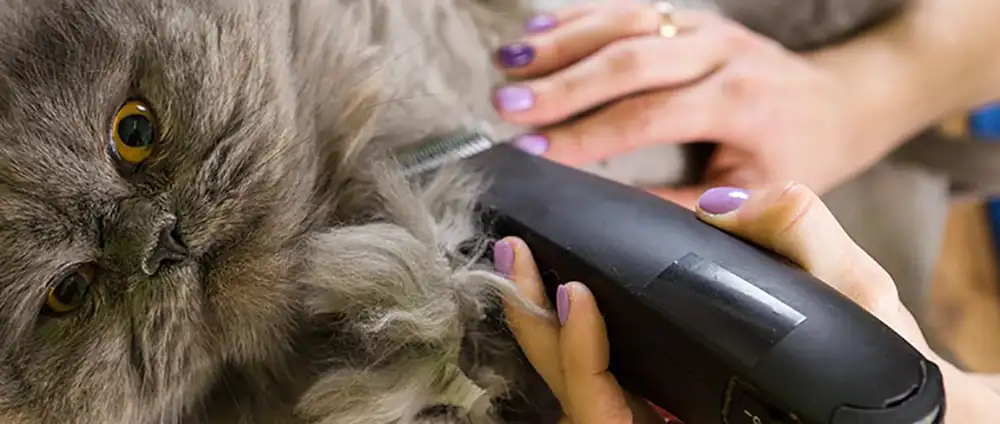
Shaving matted fur might seem like a quick and easy solution, but it’s generally not recommended for DIY attempts. Here’s why:
- Risk of Injury: Cats have very thin skin, and even the slightest slip with clippers or razors could lead to nicks and cuts. Their wiggling and discomfort during the process further increase the risk of accidental injury.
- Uneven Shave Job: Achieving a smooth, even shave, especially on a wiggly cat, is a challenging feat. Uneven patches can leave your cat feeling exposed and uncomfortable.
- Stressful for Your Cat: The buzzing sound of clippers and the restraint needed for shaving can be highly stressful for your cat. Positive reinforcement techniques are difficult to implement during shaving, potentially damaging your bond.
Alternatives to DIY Shaving:
- Professional Grooming: The safest and most effective option for dealing with severe matting is to consult a professional groomer. They have the experience and equipment to remove mats safely and efficiently, minimizing stress for your cat.
- Veterinary Intervention: In cases of extensive matting or if your cat has underlying skin issues, veterinary attention might be necessary. Your veterinarian can address any medical concerns and may recommend sedation for a safe and comfortable grooming experience.
Remember: Shaving should be a last resort, only considered under professional guidance. If the mats are minor and you feel comfortable, detangling with the methods mentioned earlier might be an option. However, prioritize your cat’s safety and well-being above all else.
Conclusion
Finding matted fur on your cat can be concerning, but with the right approach, you can address the issue and prevent future problems. Regular brushing, a healthy diet, and addressing any underlying medical conditions are key to keeping your cat’s fur tangle-free. If you encounter matting, prioritize patience and gentle detangling techniques. When faced with severe mats or a stressed cat, don’t hesitate to seek help from a professional groomer or veterinarian. With proper care and attention, you can ensure your feline friend maintains a healthy, comfortable, and tangle-free coat.
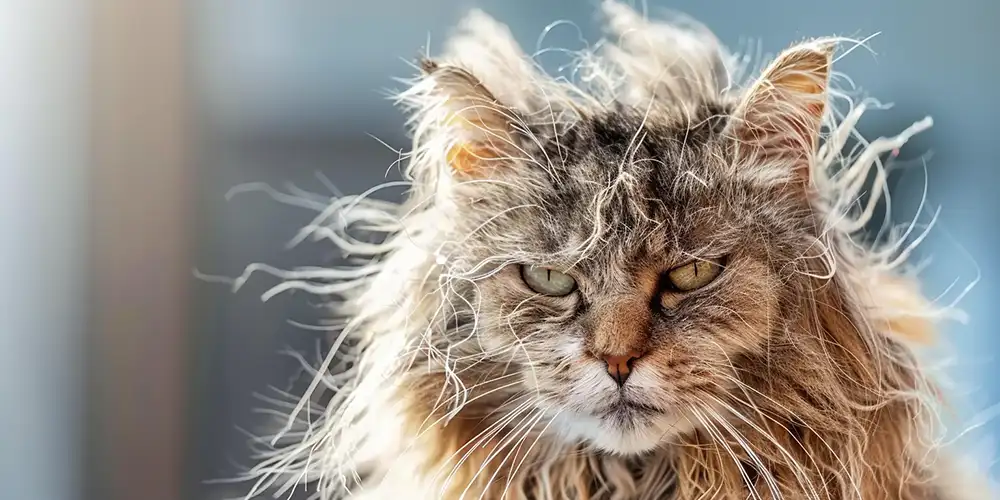
FAQ
Q: How often should I brush my cat to prevent matting?
A: The frequency of brushing depends on your cat’s breed and fur length. Longhaired cats or those with thick undercoats require daily brushing, while shorthaired breeds might benefit from brushing every other day or a few times a week.
Q: What are some signs of matted fur in my cat?
A: Signs of matted fur include clumps of fur that feel tangled or pull easily, visible skin irritation beneath the mats, and difficulty grooming themselves.
Q: Can I bathe my cat to help remove mats?
A: This is generally not a good idea. Just imagine a rope, tie a knot with it. Then put it under water and tell me what happened with the knot ? Yes, it is much more difficult to remove it now ….
In some cases, a lukewarm bath with a gentle pet shampoo can help loosen mats and make them easier to remove but we don’t recommend to wet the fur when there’s mats.
Q: How can I tell if my cat has a medical condition causing the matting?
A: If the matting seems excessive or sudden, your cat exhibits signs of skin irritation, or they seem lethargic and withdrawn, it might indicate an underlying medical condition. Consult your veterinarian for a proper diagnosis and treatment plan.
Q: Can I use human detangling products on my cat?
A: Absolutely not! Human detangling products can irritate your cat’s skin and eyes. Always consult your veterinarian before using any product on your cat’s fur.
Q: How much does professional grooming cost for matted fur removal?
A: The cost of professional grooming for matted fur removal can vary depending on the severity of the matting, your location, and the groomer’s experience. It’s best to contact groomers in your area for quotes.